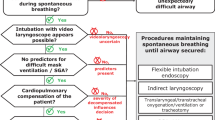Abstract
Purpose
The aim of this study is to compare free-breathing routine multi detector computed tomography (MDCT) and laryngo-tracheal (LT) flexible endoscopy in the evaluation of tracheal impairment in children with vascular ring (VR).
Materials and methods
We performed a retrospective and monocentric study of all patients with VR from 1997 to 2014. Clinical data included: initial symptoms, type of surgery and clinical outcome. MDCT were blindly reviewed by two radiologists in consensus, independently of LT endoscopy results. Radiologic and endoscopic results were reviewed according to four criteria: percentage of tracheal narrowing, distance of the compression from carina, presence of bronchial compression and signs of tracheomalacia (TM). Concordance was evaluated for each criterion with a Spearman coefficient.
Results
From 1997 to 2016, 21 patients with a vascular ring were operated on, among which 57% by thoracoscopy: double aortic arch (n = 14), Neuhauser anomaly (n = 4) and Right aorta + aberrant right subclavian artery (n = 3). 90% of them presented with respiratory symptoms among which 43% of stridor. Chest X-ray was suggestive of VR in 87% of the cases. MDCT images and LT endoscopy results were available and analyzed for nine patients. Concordance (Spearman correlation coefficient) was excellent for percentage and level of tracheal narrowing (1) and good for TM (0.79).
Conclusion
Free breathing routine MDCT is a reliable exam compared to LT endoscopy in the evaluation of tracheal impairment in children with VR. In case of respiratory symptoms (except stridor) and suggestive chest X-ray of VR, endoscopy could be avoided and routine MDCT alone performed.


Similar content being viewed by others
References
Stojanovska J, Cascade PN, Chong S et al (2012) Embryology and imaging review of aortic arch anomalies. J Thorac Imaging 27:73–84. https://doi.org/10.1097/RTI.0b013e318218923c
Yamagishi H, Srivastava D (2003) Unraveling the genetic and developmental mysteries of 22q11 deletion syndrome. Trends Mol Med 9:383–389
Kau T, Sinzig M, Gasser J et al (2007) Aortic development and anomalies. Semin Interv Radiol 24:141–152. https://doi.org/10.1055/s-2007-980040
Boudewyns A, Claes J, Van de Heyning P (2010) Clinical practice: an approach to stridor in infants and children. Eur J Pediatr 169:135–141. https://doi.org/10.1007/s00431-009-1044-7
Anand R, Dooley KJ, Williams WH, Vincent RN (1994) Follow-up of surgical correction of vascular anomalies causing tracheobronchial compression. Pediatr Cardiol 15:58–61. https://doi.org/10.1007/BF00817607
Erwin EA, Gerber ME, Cotton RT (1997) Vascular compression of the airway: indications for and results of surgical management. Int J Pediatr Otorhinolaryngol 40:155–162
Han MT, Hall DG, Manché A, Rittenhouse EA (1993) Double aortic arch causing tracheoesophageal compression. Am J Surg 165:628–631
Etesami M, Ashwath R, Kanne J et al (2014) Computed tomography in the evaluation of vascular rings and slings. Insights Imaging 5:507–521. https://doi.org/10.1007/s13244-014-0343-3
Lee EY, Siegel MJ, Hildebolt CF et al (2004) MDCT evaluation of thoracic aortic anomalies in pediatric patients and young adults: comparison of axial, multiplanar, and 3D images. AJR Am J Roentgenol 182:777–784. https://doi.org/10.2214/ajr.182.3.1820777
Türkvatan A, Büyükbayraktar FG, Olçer T, Cumhur T (2009) Congenital anomalies of the aortic arch: evaluation with the use of multidetector computed tomography. Korean J Radiol 10:176–184. https://doi.org/10.3348/kjr.2009.10.2.176
Lee EY, Mason KP, Zurakowski D et al (2008) MDCT assessment of tracheomalacia in symptomatic infants with mediastinal aortic vascular anomalies: preliminary technical experience. Pediatr Radiol 38:82–88. https://doi.org/10.1007/s00247-007-0672-1
Lee EY, Zurakowski D, Waltz DA et al (2008) MDCT evaluation of the prevalence of tracheomalacia in children with mediastinal aortic vascular anomalies. J Thorac Imaging 23:258–265. https://doi.org/10.1097/RTI.0b013e31817fbdf7
Horváth P, Hucin B, Hruda J et al (1992) Intermediate to late results of surgical relief of vascular tracheobronchial compression. Eur J Cardio Thorac Surg 6:366–371 (discussion 371)
Fleck RJ, Pacharn P, Fricke BL et al (2002) Imaging findings in pediatric patients with persistent airway symptoms after surgery for double aortic arch. AJR Am J Roentgenol 178:1275–1279. https://doi.org/10.2214/ajr.178.5.1781275
Boiselle PM, Feller-Kopman D, Ashiku S et al (2003) Tracheobronchomalacia: evolving role of dynamic multislice helical CT. Radiol Clin N Am 41:627–636
Chan MSM, Chu WCW, Cheung KL et al (2005) Angiography and dynamic airway evaluation with MDCT in the diagnosis of double aortic arch associated with tracheomalacia. AJR Am J Roentgenol 185:1248–1251. https://doi.org/10.2214/AJR.04.1493
Gilkeson RC, Ciancibello LM, Hejal RB et al (2001) Tracheobronchomalacia: dynamic airway evaluation with multidetector CT. AJR Am J Roentgenol 176:205–210. https://doi.org/10.2214/ajr.176.1.1760205
Snijders D, Barbato A (2015) An Update on diagnosis of tracheomalacia in children. Eur J Pediatr Surg Off J Aust Assoc Pediatr Surg Al Z Für Kinderchir 25:333–335. https://doi.org/10.1055/s-0035-1559816
Naidich DP, Harkin TJ (1995) Airways and lung: correlation of CT with fiberoptic bronchoscopy. Radiology 197:1–12. https://doi.org/10.1148/radiology.197.1.7568805
Author information
Authors and Affiliations
Corresponding author
Ethics declarations
Conflict of interest
The authors declare that they have no conflict of interest.
Research involving human participants and/or animals
This article does not contain any studies with human participants or animals performed by any of the authors.
Informed consent
All data in this article are completely anonymous, therefore, this clinical study did not require any informed consent.
Rights and permissions
About this article
Cite this article
Muller, C.O., Derycke, L., Kheniche, A. et al. Routine multi detector computed tomography evaluation of tracheal impairment compared to laryngo-tracheal endoscopy in children with vascular ring. Pediatr Surg Int 34, 879–884 (2018). https://doi.org/10.1007/s00383-018-4279-4
Accepted:
Published:
Issue Date:
DOI: https://doi.org/10.1007/s00383-018-4279-4




